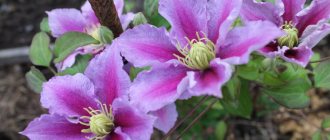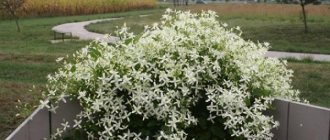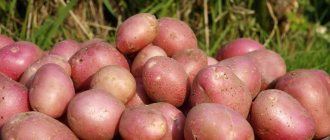Description
The clematis variety Purpurea Plenas Elegance cannot be called completely new - it was obtained at the very turn of the century more than 100 years ago in France. Its author, according to some sources, is the famous breeder F. Morel, while according to others, E. Andre. Despite its advanced age, the variety has still not lost its popularity and is one of the most widespread and sold clematis all over the world. This clematis was even awarded the highest award from the Royal Horticultural Society.
One of the names under which it is sometimes sold is Royal Velvet or Royal Velvet, which can cause some confusion among gardeners. Because the clematis variety “Evifour” is sometimes sold under the same name. They named it so for the amazing, almost velvety texture of the flower’s petals, although some gardeners claim that it disappears by the end of summer and the flowers become simply beautiful.
The clematis variety Purpurea Plenas Elegance belongs to the Viticella group, which, in turn, belongs to the third pruning group. Its flowers appear mainly on this year's shoots.
The liana has average growth energy and in particularly favorable conditions can reach 4 meters, although in Russian conditions its shoots usually grow to 2.5 - 3.5 meters.
Flowers and buds look mainly up and to the sides. The uniqueness of this clematis variety is the fact that all the flowers formed on it are double. And the absence of pistils and stamens leads to a rather unusual appearance of flowers, different from many other varieties. In addition, among the clematis of the 3rd pruning group, that is, those that manage to form flowers on the young shoots of the current year, you will find practically no double varieties. This is the privilege of clematis of the 2nd pruning group, in which similar flowers are formed on last year’s unpruned shoots.
The flowers cannot boast of large sizes; they grow only up to 5-8 cm in diameter, but they are formed in such abundance that they can form a real flowering wall.
Comment! Each shoot of Clematis Purpurea Plenas Elegans can produce up to 150 double flowers.
Their color is also somewhat unique. It is difficult to describe it clearly in words. At the moment of opening, clematis flowers are distinguished by a rich, deep dark red hue, which over time not only fades slightly in the sun, but changes and becomes reddish-purple with a violet tint. The color shade of clematis can also be determined by the composition of the soil and the level of light.
Finally, the flowering of clematis of this variety can begin as early as the end of June and can be so long that it lasts until September inclusive. It is perhaps difficult to imagine any other variety of clematis that would bloom so abundantly and for a long time, and even with double flowers. This is why Clematis Purpurea Plenas Elegans is a favorite among many gardeners.
But this is not all the advantages of the hero of the article. The frost resistance of this variety is also admirable - it can withstand frosts down to -40°C and can be grown without problems even in the harsh conditions of Western and Eastern Siberia.
In addition, the choice of light for growing clematis Purpurea Plenas Elegance is also quite large. It will not be able to grow only near the northern walls; all other exposures are quite suitable for it. Areas with light partial shade are even suitable for it. When planted in such places, flowering will only begin a few weeks later, otherwise it will be as abundant and luxurious as in the sun.
Yes, and as for resistance to diseases and unfavorable conditions in general, this variety of clematis rarely encounters any problems, especially if it is planted correctly and the basic rules for growing it are followed.
Attention! Do not expect abundant flowering from this clematis variety the next year after planting. It needs to take root and grow its root system, and then it will show itself in all its glory.
But subsequently, he is able to grow a huge number of stems and leaves, and then flowers, almost from scratch in one warm season.
Description of the variety
Judging by the photo, clematis Purpurea Plena Elegans is a cascade of double inflorescences. But experienced flower growers know that the lilac beauty, belonging to the Vitetselle species, belongs to the third pruning group. It does not require much effort to grow and is well adapted to changeable weather conditions. Such specimens are rare among terry varieties.
According to descriptions, clematis Purpurea Plena Elegans is a powerful plant with a developed root system. Its shoots can reach 4 meters. True, in the middle zone, as a rule, their length does not exceed three meters. The variety grows quickly, forming new stems.
The leaves of the clematis variety Purpurea Plena Elegance have the shape of an ellipse. Painted dark green with a glossy surface, they tightly cover the shoots. Therefore, even before flowering, the plant looks very attractive.
The description of the characteristics of clematis Purpurea Plena Elegance contains the following features:
- Cold resistance. Does not stop or slow down the formation of new inflorescences in cold and cloudy weather.
- Resistance to lack of moisture. Its roots are capable of extracting it from deep layers of soil. More negative consequences are caused by excessive watering or soaking of roots due to sudden melting of snow or heavy rains.
- Frost resistance. According to reviews from flower growers, clematis Purpurea Plena Elegans overwinters well under shelters even at temperatures of –35˚ –40˚C.
All of the above qualities of the Purpurea Plena Elegance variety allow it to be grown in almost any region of Russia, including in areas with a harsh climate.
Which pruning group does it belong to?
This variety forms inflorescences on the shoots of the current year. Therefore, pruning of clematis Purpurea Plena Elegance is carried out as a variety belonging to the third group. In the fall, some time before sheltering for the winter, the shoots are cut off, leaving 2-3 buds on each of them.
Landing
Planting clematis is a very responsible matter, since the plants have a long lifespan and, with the right approach, can delight you for up to 20 years or more.
Choosing a place and time for landing
The most important parameter for all clematis, without exception, is a place with good drainage, in which there is never stagnation of water, especially in early spring when meltwater melts. And rain moisture, especially from roofs, should not fall on clematis bushes in abundance. These luxurious vines are very fond of watering and humidity, but stagnation of water in the root zone is strongly discouraged.
The sun, of course, is very desirable, but Purpurea Plenas Elegance can make do with semi-shaded conditions if necessary. As mentioned earlier, its development in this case will only slow down somewhat.
Constant winds and drafts are also very undesirable - clematis can be protected from them by a wall or another powerful bush or even a tree.
The time of planting is determined by the type of seedling. If you have a plant with an open root system, then you can plant it either in early autumn or late spring.
Seedlings with a closed root system are planted at any time during the warm season.
Selection of seedlings
It is best to buy seedlings whose buds are still dormant. Clematis seedlings with leaves can only be purchased in containers.
Advice! Do not purchase seedlings with whitish shoots - they have been stored for too long in the wrong place and can cause you a lot of problems.
Of course, clematis plants should not show visible signs of damage or disease.
Soil requirements
The Purpurea Plenas Elegance variety, like most clematis, prefers well-fertilized, light, well-drained soils in which the roots will breathe and actively grow. If your site has high acidity, be sure to add wood ash or lime when planting.
How to plant
Clematis are planted in large, specially prepared holes, about a quarter of a cubic meter in size, pre-filled with a mixture of suitable soil, humus or compost, wood ash and a complex of fertilizers. At the bottom of the pit, it is advisable to additionally lay a drainage layer of sand and pebbles. In such conditions, the roots of the vine will be comfortable, and it will thank you with lush flowering.
The landing site is usually prepared in advance, preferably several weeks in advance. It is immediately necessary to take care of stable supports that are dug into the ground even before planting. When planting, the roots of clematis must be straightened and gradually covered with earth. It is customary to deepen the root collar from 3 to 10 cm. But be careful with the deepening when planting in the northern regions; it is better to generously cover the planting site with a thick layer (up to 10-15 cm) of organic materials.
Immediately after planting, the clematis seedling is tied to supports; later the shoots will find their way up on their own.
Planting and caring for clematis Purpurea Plena
Clematis Purpurea Plena can grow in one place for more than 20 years, delighting others with its beauty. In order for the vine to feel comfortable and bloom actively, you should know what is necessary for it.
Recommended timing
Clematis Purpurea is planted in early spring, after the danger of return frosts has passed, or in the fall, a month before the onset of cold weather. Ready-made seedlings with a closed root system take root well in any warm season.
Choosing a suitable location
Clematis is best suited to sunny locations with shade during the midday hours. The Elegance plant prefers light, fertile soils - sandy loam or loam with a weak alkaline reaction and good drainage. The groundwater must lie deep, otherwise the roots will rot. You can create a hill or mound to raise the plant. Purpurea Plena does not like drafts, so on some side the bush must be protected by a wall. The Elegance plant covering the wall of the house should be protected from rainwater running down from the roof by planting it at a distance of half a meter.
Selection and preparation of planting material
Clematis Purpurea should be planted during its dormant period. The seedling must have developed, healthy, undamaged roots and a small “stump” of lignified shoots without signs of the beginning of the movement of juices. It is permissible to purchase a seedling with leaves if it is sold in a container with soil. This clematis will easily take root, because it will be practically undisturbed during transplantation.
Landing algorithm
Clematis Purpurea Plena is planted in holes about half a meter deep and wide. The sequence of actions is as follows:
- They think over and install a support for the vine.
- Drainage is laid at the bottom of the hole, then a fertile soil mixture of soil, humus and compost. It is also recommended to add ash and complex fertilizer.
- The soil is formed into a mound at the bottom of the hole, a seedling is placed on it and the roots are straightened.
- The hole is covered with earth so that the root collar is covered with a layer of 5–10 cm.
- Fresh planting must be watered abundantly.
Care
Despite all its unpretentiousness, clematis Purpurea Plenas Elegance requires at least minimal attention.
Watering
Regular and fairly abundant watering is very important for clematis, because a lack of moisture will not allow the plants to fully absorb all the nutrients and the flowering period may be shortened, and this cannot but affect the abundance.
It is advisable to water the plants in cloudy weather or after sunset about 3-4 times a week.
Top dressing
If planting is organized correctly, clematis will not need fertilizing in the first year. But, starting from the second year of life on your site, they must be regular and full, otherwise, where will the vines get so much strength for flowering.
You can feed clematis with both mineral and organic fertilizers once every 2-3 weeks, and once a month it is advisable to spray the leaves with microelements in chelated form.
Mulching
Clematis, as a rule, adore the sun, which cannot be said about their roots, which prefer coolness and humidity. Therefore, it is very important to constantly keep the root zone covered with a thick, loose layer of mulch. This layer will also help retain moisture and provide additional nutrition to the clematis roots, which will never be unnecessary.
It is advisable to regularly (once a month) supplement the mulch layer with fresh material - mown hay, sawdust or compost.
Trimming
In the first planting season, absolutely all clematis are pruned at a height of 2-3 buds from ground level. Subsequently, with clematis Purpurea Plena Elegance, the same procedure is repeated every autumn. And every year in the spring it begins an almost new life, growing shoots almost from the ground itself.
Shelter for the winter
Since clematis Purpurea Plena Elegans is pruned very short for the winter, there is no need for the construction of special shelters. It only needs to be covered with a thicker layer of humus and covered with non-woven material, which is strengthened so that it is not blown away by the wind.
In the spring, with the onset of the first warm days, begin to gradually clear the root zone, raking away the mulch to prevent the roots from drying out.
Disease and pest control
The clematis variety Purpurea Plenas Elegans shows good resistance to most diseases. But in early spring, when the buds wake up, you can carry out preventive treatment against diseases of the root zone with Fitosporin, and preventive treatment with Fitoverm will help against pests.
Advice! Every spring, add a bucket of a mixture of sand and wood ash to the clematis root zone.
Description of Clematis Purpurea Plena Elegans
Clematis Purpurea Plena is not the tallest variety among Viticella, growing on average to 2.5–3 m in height. The lashes of the Elegance vine are densely covered with green oval leaves. The flowers are double, noble burgundy in color, 6–9 cm in diameter. The buds are formed on young shoots, located along the entire length, directed upwards and to the sides. The root system of clematis is powerful and well developed. The bush takes up a lot of space - 3-4 square meters. m. Elegance blooms for three summer months.
Frost resistance, drought resistance
Clematis Purpurea Plena Elegans loves light and warmth, but at the same time can withstand frosts down to -40˚C. Of course, in regions with harsh winters, the plant must be covered for the winter. This is done after the first frost, in dry weather. In summer, Elegance liana needs frequent watering, especially in dry weather. The soil should not be allowed to dry out. At the same time, you need to ensure that there is no stagnation of moisture in the roots.
Resistance to diseases and pests
Clematis Purpurea is susceptible to various fungal diseases: gray rot, fusarium, powdery mildew, rust, wilt. It is attacked by harmful insects - mealybugs, nematodes, slugs and snails, spider mites, aphids, bedbugs, scale insects. For the root system of clematis Purpurea Plena, the danger comes from mole crickets and rodents, which can destroy the plant completely.
Reproduction
The following propagation methods are well suited for Clematis Purpurea Plenas Elegans:
- By dividing the bush, it is optimal to propagate plants that have reached the age of 4-5 years. You can do this procedure in the fall or spring, digging up and separating part of the bush.
- By cuttings you can get many new clematis plants at once. It is better to cut cuttings before flowering, using 3-4 year old bushes. A shoot cut from the middle is cut into pieces 6-7 cm long, with at least two buds, which are placed in a mixture of peat and sand and kept until rooting with constant moisture.
- Layering is the simplest method, in which mature clematis shoots are placed to a depth of about 10 cm in specially dug grooves and covered with a light mixture, leaving only the very tip of the shoot on the surface. A new plant is separated only for the next season.
- It makes no sense to use the seed method, since this variety of clematis is a hybrid and among the seedlings there is unlikely to be a representative similar to the mother plant.
Methods for propagating clematis
Clematis Purpurea Plena Elegans propagates by seeds, dividing the bush, cuttings and layering. The seed propagation method is practically not used by gardeners; it requires a lot of time and patience. The vegetative one is more reliable:
- Dividing an Elegance bush - a plant no older than 7 years old is dug up, divided into parts with sufficiently developed roots, and the shoots are shortened.
- Reproduction by layering - the shoots that have grown in the spring are laid on the ground and dug in. As soon as they take root, you can start planting.
- Cuttings - young cuttings are cut and planted under film or a plastic bottle.
Reviews
Anatoly, 43 years old, Omsk
My wife and I are trying together to make our site more comfortable. Not long ago we discovered clematis, and one of the most beloved was the Purpurea Plenas Elegance variety. I can’t even believe that this beauty is capable of growing in our harsh climate, but over the summer it manages to grow a huge amount of green mass, which in the second half of summer is still covered with flowers.
Oksana, 34 years old, Ulbyanovsk
I haven’t been growing clematis for long, but I already have some favorites. Among them is Purpurea Plenas Elegance. It seems that this vine can bloom endlessly. And it grows quickly, in two years it managed to weave a lattice 1.5 meters wide and reached the roof.
Maria, 38 years old, Bryansk
To be honest, I was always afraid to get involved with clematis - I considered them very capricious. But last year I couldn’t stand it and planted Purpurea Plenas Elegance. The most interesting thing is that it bloomed in the first year after planting. I picked off the flowers to save him strength for the winter. So every day I had to remove almost 20 buds from the clematis bush, but it continued to form new ones.
Caring for clematis Purpurea Plena Elegans
Despite the intricate name, clematis is undemanding in care, but it needs a little attention. The main components of plant care: watering, fertilizing, mulching, pruning.
Watering
Should be moderate but regular. Lack of moisture will negatively affect the growth and development of the plant, the duration and quality of flowering. Clematis Purpurea Plena Elegance should be watered after sunset in accordance with weather conditions. During hot, dry periods, this must be done every other day, the main thing is to prevent the soil from drying out.
Top dressing
In the first year, clematis Purpurea Plena Elegance will have enough of the substances that were placed in the planting hole. From the second year, the plant must be fed with mineral and organic fertilizers. In April and May, clematis needs nitrogen and calcium fertilizers, and in the fall - phosphorus. You should mainly use solutions of mullein or bird droppings with the addition of mineral fertilizers. Foliar feeding of Elegance with chelated fertilizers by spraying on the leaf is also recommended.
Mulching and loosening the soil
Covering the soil with compost, hay or sawdust in the root zone is important for the health of Clematis Purpurea Plena Elegance. This protects the roots from overheating, helps retain moisture and provide additional nutrition. In addition, it eliminates the need to regularly loosen the soil and remove weeds, as it prevents them from growing Elegance. The mulch layer must be updated once a month.
Trimming
All clematis are conventionally divided into 3 groups according to the principle of pruning. Clematis Purpurea Plena Elegance is a variety belonging to the third group, which requires almost complete removal of annual shoots. In late autumn, all the mass that has grown during the warm season is cut out, leaving 2-3 buds on each vine. This is necessary because the Elegance plant produces flowers only on young shoots. In the spring it will rapidly grow and last year’s branches will become unnecessary ballast, wasting life’s juices. In addition, pruning helps clematis to overwinter better and not freeze even in severe frosts.
Important! In the summer, Clematis Purpurea Plena Elegans is pruned repeatedly. This is necessary for the formation of the bush and prolongation of the flowering period.
Garter
Usually the vine itself clings to supports with special tendrils. But if there is a need to give it direction, to form a bush, you can resort to a garter. The lower tier of clematis Purpurea Plena is fixed at a minimum distance from the ground. Then, as they grow, the shoots are fixed at a new height. It is important to ensure that they do not intertwine with each other. This will ensure uniform illumination and help avoid injury.
Preparing for winter
In order for the plant to comfortably overwinter, a number of measures should be taken. A month before pruning, clematis Purpurea is watered (if the weather is dry) and fertilized with ash. 2 weeks before frost, the Elegance vine is pruned and treated with a fungicide. Solutions of Bordeaux mixture or ferrous sulfate are often used. Be sure to add phosphorus-potassium fertilizers and humus to the roots. It is not recommended to apply nitrogen in the fall, since it contributes to the growth of vegetative mass, and in the cold season this is useless.
Sheltering shrubs for the winter
This is the most important part of the pre-winter preparation of Clematis Purpurea Plena Elegance. The bush is hilled by adding peat and humus to the dry soil. It is necessary to hide the root neck of the flower; for this, use a mixture of ash and sand. You can also cover the plant with peat, compost, sawdust, spruce branches or material specially designed for this purpose.
Attention! Witicellas must be covered with the onset of frost. Freezing of damp soil is detrimental to the flower, so it needs to be insulated in dry weather. In spring, the cover must be removed in time to prevent the plant from dying out.
Diseases and pests, methods of control and prevention
Diseases and pests that affect clematis must be detected in a timely manner. Damp, cool weather is favorable for their spread - you need to be alert. Promptly taken measures will allow you to get rid of the problem quickly and without losses. For the prevention and control of fungal infections, spraying with fungicides, iron or copper sulfate, and Bordeaux mixture is effective. To destroy harmful insects, Purpurea Plena needs to be treated with insecticides - they are sold in stores in a wide range. Planting marigolds, garlic, parsley, coriander, and calendula next to clematis helps scare away uninvited guests.
Clematis purpurea Plena is attractive to rodents. They should be fought with poisoned baits. Elderberry or wild rosemary branches placed around the plant have a repellent effect.
Advice! To prevent rodents from settling under the winter shelter and destroying the clematis elegans, it is recommended to make the top layer from dog mint branches - their smell will help repel pests.
Planting a plant
Planting a vine is not very difficult, but there are certain features in this procedure. If they are not taken into account, the plant will develop poorly, become sick and will not bring the desired result to the grower.
Site selection and preparation
Choosing the right site is the basis for successfully growing clematis. The plant needs good drainage, completely eliminating stagnation of water, and a sufficient level of lighting. Purpurea Plenas Elegance can grow in partial shade, but its development in this case will slow down a little.
The liana should be protected from drafts and strong winds.
For cultivating clematis, light, well-drained soil with a large supply of nutrients is preferred. The root system must be able not only to actively grow, but also to breathe. In areas with high acidity, lime or wood ash is added before planting.
Planting dates and technology
The time for planting clematis Purpurea Plena Elegance is determined depending on the type of seedling. If its root system is of the open type, then the bush should be planted on the site in early autumn or late spring. A liana with a closed type of root system is transplanted to a permanent place of growth from spring to autumn at any time.
For planting, you should purchase clematis seedlings with dormant buds. A bad sign is whitish shoots on plants. This suggests that they were stored for a long time in unsuitable conditions, and in the future such vines will cause the gardener a lot of unnecessary trouble. Seedlings should not have mechanical damage or signs of disease.
Clematis is planted in pre-prepared holes approximately 1⁄4 cubic meters in size. They are first filled with a mixture of soil, compost, fertilizers and ash.
Instead of compost, humus can be used. A layer of drainage material (expanded clay, pebbles, sand or broken brick) is poured onto the bottom. The planting pit is prepared several weeks before the seedling is planted. At the same time, reliable supports are installed, which must be dug into the ground. The nutritious soil mixture is poured onto the bottom of the hole in the form of a mound, over the surface of which the clematis roots are carefully spread. Its root collar should be buried 3-10 cm.
See also
Description of burning clematis, planting and care in open ground, reproduction
Read











